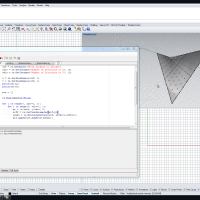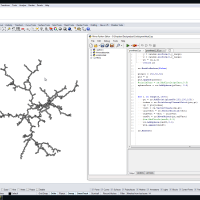Advanced Scripting: 02 Koch Snowflake
Course or Collection:
Software:
Tag:
Video Duration:
7 minutes
In this tutorial we create a Koch Snowflake. To do it, we create two methods, CreateTri and CreateKochSnowflake. This component as a boolean toggle to invert the snowflake. It works by reversing the polyline direction. It's kinda cool. Check out the video and the code.
//Create an empty list of lines to hold our snowflake curves List<Line> lines = new List<Line>(); //Call the CreateTri function and pass the radius and flip parameters Polyline tri = CreateTri(radius, flip); //Create an array of Lines by extracting the segements from the triangle Line[] triangle = tri.GetSegments(); //Add these three lines to the lines List lines.Add(triangle[0]); lines.Add(triangle[1]); lines.Add(triangle[2]); //Create a temporary list of lines List<Line> tempList = new List<Line>(); //Begin the while loop int i = 0; while(i < num){ //make sure the list is empty by calling the Clear() method tempList.Clear(); tempList.AddRange(lines); lines.Clear(); lines.AddRange(CreateKochSnowflake(tempList)); i++; } A = lines; }
public List<Line> CreateKochSnowflake(List<Line> lines){ List<Line> newLines = new List<Line>(); foreach( Line ln in lines){ //Get the length of the line and 4 points to define new snowflake edge double tempLength = ln.Length; Point3d ptStarttemp = ln.PointAt(0.0); Point3d pt1temp = ln.PointAt(0.333); Point3d pt2temp = ln.PointAt(0.666); Point3d ptEndtemp = ln.PointAt(1.0); //Create a new line and rotate it by 60 degs or PI/3 Line rotatedLine = new Line(pt1temp, pt2temp); rotatedLine.Transform(Rhino.Geometry.Transform.Rotation(Math.PI / 3, pt1temp)); //Create a new point from the end of the rotatedLine and complete the lines Point3d triTop = rotatedLine.PointAt(1.0); Line completeTriLine = new Line(triTop, pt2temp); Line lnStart = new Line(ptStarttemp, pt1temp); Line lnEnd = new Line(pt2temp, ptEndtemp); //Add all of the lines to the newLines list in order newLines.Add(lnStart); newLines.Add(rotatedLine); newLines.Add(completeTriLine); newLines.Add(lnEnd); } return newLines; }
public Polyline CreateTri(double radius, bool reverseTri) { List<Point3d> pts = new List<Point3d>(); //Angles for triangle points const double ang0 = (Math.PI / 2); const double ang1 = (7 * Math.PI / 6); const double ang2 = (11 * Math.PI / 6); //Create the three points of the triangle Point3d pt0 = new Point3d(radius * Math.Cos(ang0), radius * Math.Sin(ang0), 0); Point3d pt1 = new Point3d(radius * Math.Cos(ang1), radius * Math.Sin(ang1), 0); Point3d pt2 = new Point3d(radius * Math.Cos(ang2), radius * Math.Sin(ang2), 0); //Add the points to the pts list pts.Add(pt0); pts.Add(pt1); pts.Add(pt2); //Create a new polyline called pl Polyline pl = new Polyline(); //loop through the list of points(should only be three but will use any number b/c we aren't checking BAD!) foreach(Point3d pt in pts){ pl.Add(pt); } //Add a copy of the first point to the end of the list to close the polyline pl.Add(pts[0]); //Check to see if the polyline should be reversed and if true...call the reverse method if(reverseTri == true){ pl.Reverse(); } return pl; }
Tutorial Files:
Want to Contribute?
Want to be an author? Drop us a line here we'd love to have you.
Already have a video you'd like to post? Send us a link and we'll get you going.
:)



